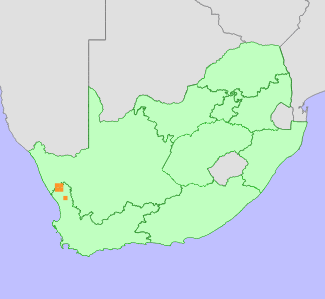|
Scientific Name | Conophytum obcordellum (Haw.) N.E.Br. subsp. stenandrum (L.Bolus) S.A.Hammer |
Higher Classification | Dicotyledons |
Family | AIZOACEAE |
Synonyms | Conophytum stenandrum L.Bolus |
National Status |
Status and Criteria | Endangered A4d |
Assessment Date | 2021/12/01 |
Assessor(s) | A.J. Young, P.G. Desmet, I. Ebrahim, D. Guo, A. Harrower, L. Jabar, L. Knoetze, C. Rodgerson, P.C.V. Van Wyk & N.N. Mhlongo |
Justification | This succulent is endemic to the Western Cape and Northern Cape province of South Africa with an extent of occurrence (EOO) of 776 km2 and area of occupancy (AOO) of 112 km2. The population is in decline due to illegal collection for the ornamental succulent plant trade, with collection likely to increase as there has been a dramatic increase in the number of species and volume of plants targeted since 2019. This succulent is shorter-lived and generally more challenging to grow in cultivation than closely related taxa which is likely to further the demand for habitat-collected plants. The continued threat of illegal collection is therefore regarded as very high resulting in a likely overall decline of between 50 and 75% of the population within the next three generations (60 years). While climate change is also highly likely to impact this taxon the rapid declines to the population as a result of illegal collection means it qualifies as Endangered under criterion A4. |
Distribution |
Endemism | South African endemic |
Provincial distribution | Northern Cape, Western Cape |
Range | This dwarf succulent is endemic to the Western Cape and Northern Cape province of South Africa. |
Habitat and Ecology |
Major system | Terrestrial |
Major habitats | Fynbos, Succulent Karoo |
Description | This succulent is restricted to small areas of the Fynbos and Succulent Karoo biomes. The dominant habitat is granite where the plants are typically found in shallow weathered depressions filled with grit.
This taxon has a generation length of 20 years. It is expected to be sensitive to the impacts of climate change as it does not disperse and while adapted to arid conditions, is dependent on limited seasonal rainfall. Species in the genus are sensitive to long periods of drought. Drought related mortality has been observed for other closely related taxa within the genus. |
Threats |
| This taxon is in decline due to the illegal collection of mature individuals for the international trade in ornamental succulents since 2019 and the population is in decline as a consequence. This succulent has been highly sought after by collectors and is highly likely to remain so in future. As a result a population decline of 50-75% is suspected over three generations (60 years).
There is no decline in habitat quality for this taxon as inferred by changes in vegetation cover determined from changes in Enhanced Vegetation Index (EVI) between 1984 and 2018 using Landsat data (Venter et al. 2020). However, anthropogenic climate change is predicted to be a long-term threat to this succulent. Climate models for the likely emission scenarios where emissions stay at present day levels (RCP 2.6) (Hausfather and Peters 2020) and worst case scenarios where emissions continue to increase during the 21st century (RCP 8.5) indicate that there will be a loss of suitable bioclimatic envelope of between 26% and 57% by 2080 for this taxon. Species in this genus have limited dispersal ability and migration to suitable habitats elsewhere is regarded as highly unlikely. |
Population |
This succulent often occurs as scattered individuals, occasionally it may be locally common. There are no formal estimates of population size for this species but there are probably between 10,000 and 50,000 mature individuals. The population is experiencing initial levels of decline due to illegal collection for the ornamental succulent plant trade.
|
Population trend | Decreasing |
Assessment History |
Taxon assessed |
Status and Criteria |
Citation/Red List version | | Conophytum obcordellum (Haw.) N.E.Br. subsp. stenandrum (L.Bolus) S.A.Hammer | Least Concern | Raimondo et al. (2009) | |
Bibliography |
Hammer, S. 2002. Dumpling and his wife: New view of the genus Conophytum. EAE Creative Colour, Norwich.
Hammer, S.A. 1993. The genus Conophytum: A conograph. Succulent Plant Publications, Pretoria.
Hausfather, Z. and Peters, G.P. 2020. Emissions - the 'business as usual' story is misleading. Nature 577(618-620).
Opel, M.R. 2004. The rediscovery of Crassula alcicornis. Haseltonia 10:38-40.
|
Citation |
| Young, A.J., Desmet, P.G., Ebrahim, I., Guo, D., Harrower, A., Jabar, L., Knoetze, L., Rodgerson, C., Van Wyk, P.C.V. & Mhlongo, N.N. 2021. Conophytum obcordellum (Haw.) N.E.Br. subsp. stenandrum (L.Bolus) S.A.Hammer. National Assessment: Red List of South African Plants version 2024.1. Accessed on 2025/11/07 |
 Comment on this assessment
Comment on this assessment


